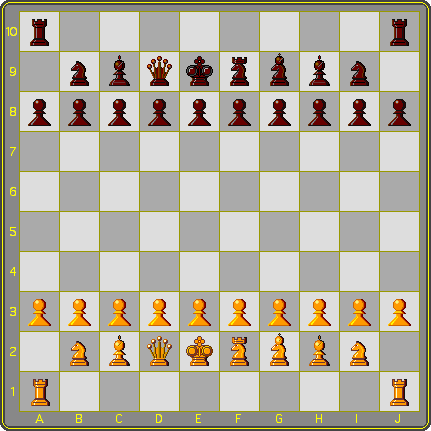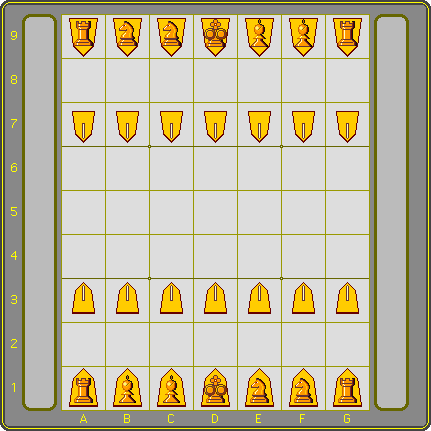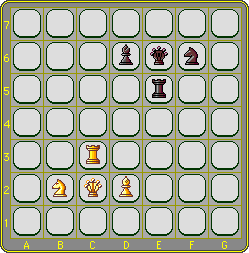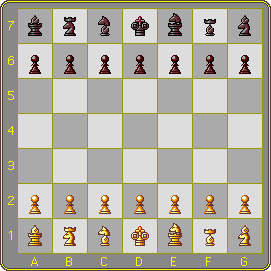| Chess variants |
|---|
| Grand Chess |
| Yari Shogi |
| Dragonfly |
| Chad |
| Rotary |
| Shakti |
| Caïssa |
| Cyclix |
| Loonybird |
| Chakra |
How difficult is it to make Chess variants? That would depend on how many you want to make per day. Three or four? No problem. It'll leave you time to work, do some simple household tasks, get the groceries and walk the dogs.
To quote D.B. Pritchard, author of The Encyclopedia of Chess Variants:
"Anyone can invent a new chess variant within ten seconds (try it) and unfortunately some people do".
 | To further discourage would be inventors: according to David there are some 2000 published Chess variants around. Here's another quote from the same source, Chess History:"The point is this: it's easy to think 'what if...the board were bigger, smaller, differently shaped; what if there were more players, more pieces, more moves...' but it is not so easy to invent a game, based on chess, which has merit in itself ... and which many people might actually enjoy playing.Not convinced? Try the Chess Variant Pages or Wiki. Note that Congo takes pride of place on the cover of the Encyclopedia, testimony to the fact that a seven year old can make in interesting and original Chess variant. |
Note also the sentence in the quote: "... but it is not so easy to invent a game, based on chess, which has merit in itself".
The fact that the writer, in spite of an overwhelming number of chess variants that have hardly anything in common with Chess, except having 'checkmate' as their object, talks about "based on Chess", rather than "based on checkmate", is an indication of how deep 'specific thinking' is entrenched in the Chess players' mindset, where Chess variants are concerned.
So why bother unless it's fun. To me making a good chess variant was mostly an excercise in implementing an interesting idea within the general context of checkmate. This, while rewarding, at the same time posed its limits. I want a set of pieces to be complete and the structure of the game logical. Congo was a deliberate attempt to get away from this: quite aware of the limitations of my approach, I tempted my son Demian at the age of seven to make a Chess variant. And Congo turned out to be a great game despite the fact that the set of pieces is quite arbitrary and the structure not emphatically logical. It features several novelties like a monkey that captures by leaping, a river where pieces may drown and extraordinary pawns. Its great fun to play, well balanced, highly tactical and in the end a Lionking with any piece, including a pawn, always wins against a bare Lionking.
A strategy game by any standard.
To me the realm of the arbitrary was largely off limits, but even in the realm of logic and completeness the possibilities were limitless. So one needs a damn good reason to add yet another variant.
Shakti and Dragonfly, just so happened. Here's the story of the others, all of which were created deliberately.
- Grand Chess
However, the traditional board is 8x8, leaving room for one additional piece. Historically it was occupied by a 'minister', a pathetic piece, but since the renaissance the position has been claimed by the queen.
The queen combines the powers of rook and bishop. That's defendable but arbitrary. There are two more combinations, the 'marshall' and the 'cardinal'. They combine the powers of rook & knight and bishop & knight respectively.
They should not have been excluded because of an arbitrary boardsize, but they were. Chess became a great game where it should have become an even greater game.
I'm not the first to signal the omission. Ever since the late 16th century the marshall and cardinal have under different names played their role in the periphery of Chess. Even last century, great players like José Raúl Capablanca and Edward Lasker tried to introduce them in Capablanca Chess. They ran into difficulties and missed the obvious.
The reason? Specific thinking.
To be fair, for quite a while I missed the obvious too. Of course I knew of the endeavours of Capablanca, but without seeing any immediate improvement, the 'complete Chess' issue remained deprived of any urgency. Grand Chess was in fact my last Chess variant and it emerged when in an unguarded moment my mind superimposed the idea of the initial set-up of Rotary on a 10x10 board. Suddenly everything came together: the square board, the regular pawn distance and connected rooks.
To Grand Chess' critics: you can't have it both ways. Trouble with rook development gave rise to a weird solution, and castling is not less weird because you're used to it. Castling is a means to an end, and the end isn't needed in Grand Chess, so don't go complaining about free ranging rooks and the absence of castling.
The rest is history. I inserted the marshall and cardinal next to the king, partly because they belong in the center, partly because the pawns appeared well defended.
In the spirit of accelleration I decided to give pawns the right to promote optionally upon reaching the 8th or 9th rank, and compulsory upon reaching the 10th.
In the spirit of completeness I decided to give pawns the right to promote only to a piece previously captured by the opponent. There are quite enough heavy pieces in Grand Chess to abandon the need for more. This gave rise to a much discussed detail: a pawn on the 9th rank, no piece being lost by its side, cannot move, but if it happens to attack the opponent's king it nevertheless gives check.
This was considered weird by some of the game's critics. How can it give check if it can't move? It's the ever present tiring chorus of people who think that having thoughts qualifies as thinking. A similar situation - a pinned piece giving check at the same time - occurs in Chess, if not often, then at least far more often than a pawn on the 9th rank in Grand Chess with no piece being lost by its side. It's no problem in terms of rules. So please.
Subsequent variants of Grand Chess include Gothic Chess (among others), Embassy Chess and Janus Chess. All three employ 8x10 boards with the rooks once again tucked tight in the corner and a castling rule to 'solve the problem' - it's not a bug, it's a feature. Gothic Chess uses the same set as Grand Chess, Embassy Chess the same set in the same configuration and Janus Chess features two cardinals but no marshall - very logical.
I'm not commenting on these commercially inspired rip-offs except that anyone can revert Grand Chess to 8x10, take away or add one feature or the other and call the resulting Capablanca clone an improvement.
Time will know and time will tell. - Yari Shogi
But Shogi doesn't have a 'complete' set of pieces. The set is obviously well balanced, but the choice of pieces is quite arbitrary, as countless Shogi variants show.
Though the pawn may be considered more logical than its western counterpart in that it captures the way it moves, there's no a priori logic in the game's stucture. So I decided to try my hand at a Shogi variant with a complete set of pieces and a logical structure - that would at least be a novelty - and with emphasis on Shogi's most prevalent characteristics: a strong forward orientation and ample opportunities for promotion. In Shogi that feature is not restricted to pawns.
After deciding on a Shogi general and Shogi pawns I went shopping for pieces. My mind is wired the 'western' way, whatever that may mean, so I turned to what to me seems logical on a square board. The rook is logical. The bishop is logical because it employs the diagonal plane. The knight is logical because it covers the first squares missed by the rook and the bishop. Put them in the middle of a 5x5 square and they each cover 8 of the remaining 24 squares. That's logical enough for me.
Mind, I was thinking 'generic', in terms of principles of movement rather than Chess pieces. The next thing was how to emphasize 'forward orientation' and 'promotion', so I made a number of choices that would at least appear logical.
- I decided on six pieces, two 'rooks', two 'bishops' and two 'knights'.
- I decided that all pieces would have the option to promote under the same conditions as in Shogi and that pawns would become 'silver' and pieces 'gold' - in the generic sense.
- To emphasize the game's forward orientation, I decided that all pieces would have the Shogi 'lance' as part of their movement options, and that silver and gold would both have the 'backward lance'. Other movement options should be restricted.
- I decided that no unpromoted piece should be able to move backward.
Chess variants are never essential, you'll have to make choices, and these were the a priori ones I made. Prepare well and all goes well: the pieces weren't too difficult after that. Even silver and gold presented themselves in a logical way without deviating too much from their Shogi counterparts.
In the spirit of Chess I made the rooks stronger than the bishops and knights: if I had allowed them only the two squares adjacent to the lance move, they would have ended up having about the same strenghts as a bishop and a knight, or even slightly weaker. That led me to reconsider rook promotion: because the rook was stronger than the other pieces and would thus profit less from promotion to gold, I decided for the natural solution of promoting the 'forward rook' to a full rook, keeping intact the 'backward lance' for all promoted pieces.
In the spirit of Shogi I decided for a rotational symmetric set-up.
That was all. It took a couple of minutes to give the world its first 'western' Shogi.
As a bonus, the name 'Yari Shogi', meaning 'Spear Shogi', presented itself as highly appropriate. - Dragonfly
Dragonfly is very much 'Chess' in its tactical aspects. It has a complete set of primary pieces. The absence of a queen is generously compensated by the dropping options. The game is practically without draws, because there's no endgame, but a gradual shift towards an more tactical phase, as the number of pawns decreases. Some may argue that this aspect does make it very much 'not Chess'. Yet it features many of the properties Fischer envisioned to engrave his superiority, which eventually led him to the ill-conceived 'Chess960'.
I could argue that Dragonfly was a premeditated attempt to merge the ideas in western Chess with those in Japanese Shogi, and get away with it. But it wasn't like that. At some point in the late seventies or early eighties, when pondering the western pawn's unique properties, I asked myself this question: 'what if, in a chess game, all pieces except the king would capture differently from the way they move' ? This resulted in Loonybird. Dragonfly came merely as an afterthought: "Hey, I can use regular pieces and have a great game!" And so it was.
It even has castling. - Chad
I gave the king the traditional move, provisionally, and chose rooks as the most logical pieces on a square board.
Now what?
It was soon established that a king in the corner with two orthogonally adjacent rooks constituted an impenetrable fortress, which left nothing else for the remaining rooks to do than strolling about aimlessly and having tea. To prevent the king from employing such unfair tactics, I decided to lock it up in a 3x3 castle that could be attacked from all sides. The king surrounded by eight rooks would fill the castle and provide a good initial set-up. It was bad thinking leading to a good approach.
Bad thinking because it did not, of course, solve the problem. One now needed four rooks instead of two, but that was all the difference it made.
A good approach nevertheless, because it made clear that without mutual capture of pieces, the game wasn't going anywhere. But having rooks slaughter one another all over the place, with mutual impotence as the most likely outcome, wasn't too tempting either.
The Wall
The solution that eventually emerged was the 'Wall', the twelve squares you can see around each castle in the diagram. It serves to restrict mutual capture of pieces to one specific condition: the mutual right to capture exists only between an attacker on the wall and a defender inside the castle.
Not only did this rule 'unlock' the game, it also offered a choice regarding promotion. You might not actually need it, but I felt the framework was now so solid that the game could profit from it. And the implementation would be logical: a rook ending its move inside the opponent's castle would promote to queen. To counterbalance its impact, I gave the king, restricted as it was to the castle, the right to move using either the king's- or the knight's move.
And that was it, basically. As a game it became very popular at the games club Fanaat of the University of Twente, with two top players demonstrating convincingly that it showed no lack of finesse.
As an exercise in minimalism it was ironically overtaken by Shakti, a chess variant that unintentionally happened some time later. It doesn't make Chad any less of a great game. - Rotary
I told the story of Rotary in the previous chapter. Here's the logical set that presented itself so easily.
- Shakti
- Caïssa
Chess variants do need a reason for being. Caïssa even has two: in the course of its invention an enigma emerged, a way of capture coined 'capture by exchange' that is in fact no capture at all, yet highly effective. It emerged from my initial choice of pieces: a rook, a bishop and a knight.
Having only one bishop creates a well known problem and I solved it by giving pieces the right to exchange places with pieces of like color. This way, a rook or knight initiating the exchange, could transpose a bishop to the other diagonal grid. Then a bold thought hit me: why not allow an exchange with the opponent's pieces too?
To cut a short story even shorter, everything that followed confirmed the idea. Chess is choice, and I made a few more in Caïssa. The king's role was taken over by the queen: the atlantis effect eventually disables even the stongest piece. To somewhat limit its abundant freedom of movement, I restricted it to the king's move if in check, and demanded the 'tile structure' - the squares still on the board - to remain connected in the king's move fashion. That way the queen could be trapped on a square it was unable to vacate because its removal would be illegal.
It was the rule that wrapped everything neatly together to a Chessbox full of fun.
In the 2003 CodeClub Challenge, Caïssa was subject of the annual game programming contest in the Netherlands.
- Cyclix
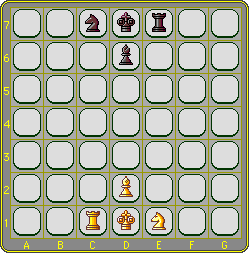
Cyclix is the third of the 'Atlantis Triplets', but its invention happened much later, in 2011, in the wake of a stacking games contest.
The story of its invention is described in 'Late arrivals and Final Whispers'. - Loonybird
The significance of the game lies in Dragonfly, which came as an afterthought. - Chakra
However, at the time I chose the wrong initial setup and the game landed on the shelf. Much later, in 2008 or so, I took a fresh look at it and saw that a wrong setup could easily have been avoided. But I was younger, back then, and more prone to miss the obvious.

